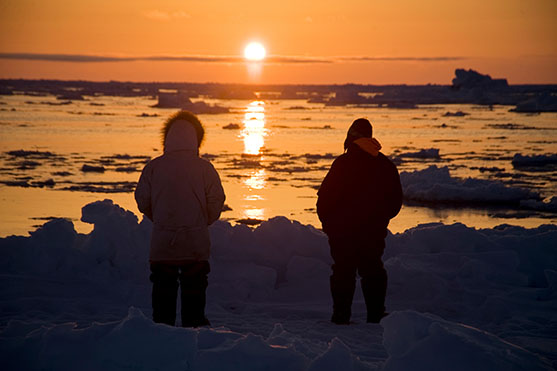Celebrating Indigenous Stewardship of Beluga Whales
Arctic Indigenous peoples' stewardship and research are vital elements of conserving abundant belugas, a healthy ecosystem and thriving communities

Beluga whales, sometimes called sea canaries for the frequent and wide range of sounds they make, are known around the world as a symbol of the Arctic. In many Arctic communities, belugas provide food as well as a connection to the sea and social cohesion. Arctic Indigenous peoples’ stewardship and research are vital elements of conserving abundant belugas, a healthy ecosystem and thriving communities.
While discussing beluga whales at a pre-pandemic conference, Inuvialuit hunters Lawrence Ruben and John Noksana, Jr. wanted the audience to hear and understand two points:
- “If you share your catch, your freezer will always be full.” This statement emphasizes a key component of Indigenous stewardship. Treating the animals well and living in harmony with others are essential to the wellbeing of people and their ecosystems.
- “We will need help.” This statement acknowledges how quickly the Arctic is changing and how important cooperation is among hunters, scientists, managers and anyone else interested in conserving abundance.
Recently, Lawrence and John joined 16 other authors from the overlapping categories of hunters, researchers and managers in producing a paper that examined Indigenous practices in beluga stewardship and research in the Arctic from Greenland across Canada and Alaska to Chukotka, Russia. The paper notes many values people in these areas hold in common, including the importance of sharing and respect for animals as well as spiritual practices such as returning the head of a whale to the sea to show that the animal was treated well.
Cooperation is another important value among hunters, and one that now extends to working with researchers. In Alaska and in the Inuvialuit Settlement Region of northwestern Canada, co-management institutions bring hunters, scientists and managers together to share ideas and make plans. Through decades of collaborative studies, they have discovered a great deal about beluga migratory patterns, genetics, diets and more. In other regions, research collaboration is growing, in no small part as everyone involved realizes what will be needed to conserve beluga populations in this time of rapid change.
In addition, the paper looks closely at a major management challenge in Nunavik (northern Quebec), Canada. There, the Western and Eastern Hudson Bay beluga populations migrate together past Inuit communities. The Western population is one of the world’s largest, but the Eastern one is deemed “threatened.” Hunters and managers are working together to create a system for monitoring the harvest, including further research to find ways to avoid hunting from the Eastern population.
The close connection between Arctic Indigenous peoples and beluga whales has long sustained healthy communities and healthy whale populations. The traditional Indigenous values of respect, cooperation and sharing are even more important today in the face of climate change and other pressures on Arctic marine ecosystems. These values now encompass respect for different knowledge systems, cooperation between hunters and scientists, and sharing of ideas and successes throughout the Arctic and beyond. What John and Lawrence emphasized at the conference is a great foundation for a strong future of collaborative stewardship for beluga whales and the communities that know them so well.